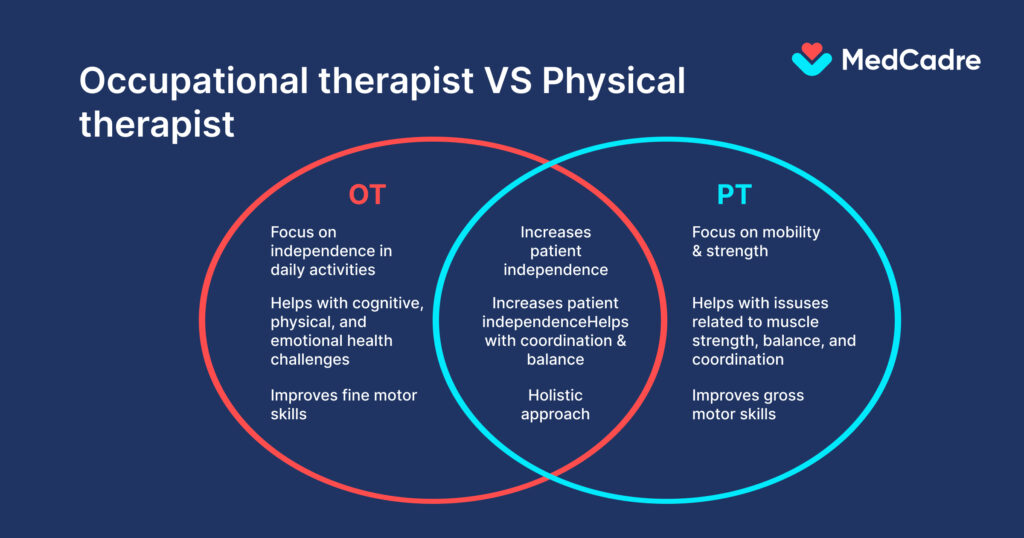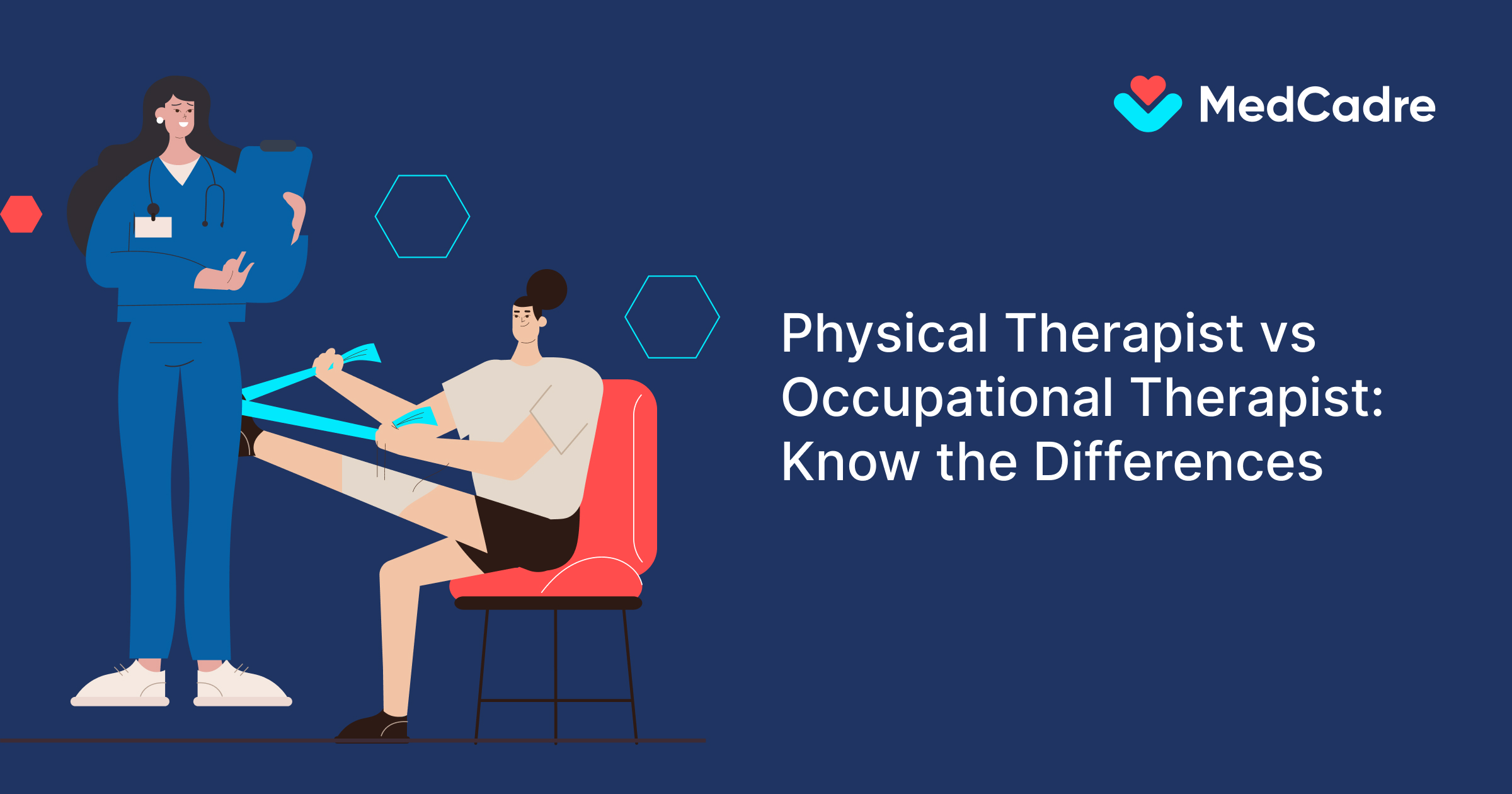Physical Therapist vs Occupational Therapist are two distinct yet closely related fields in the healthcare industry. While both professions aim to improve a person’s quality of life and functional abilities, they have unique focuses and methodologies.
In this article, we will explore the key differences between Physical Therapist vs Occupational Therapist, shedding light on their roles, educational backgrounds, and the specific populations they serve.
What is the difference between occupational therapist and physical therapist
Both occupational therapist (OT) and Physical therapist (PT) work in the rehabilitation field, but there are key differences in their scope and approach:

What is an occupational therapist vs physical therapist
Physical therapist (PT)
- Physical therapist are healthcare professionals who specialize in the diagnosis, treatment, and prevention of movement disorders. To become a licensed PT, individuals typically need to complete a bachelor’s degree in a related field, followed by a Doctor of Physical Therapy (DPT) program. DPT programs involve rigorous coursework and extensive clinical training to prepare therapist for various physical conditions.
Occupational therapist (OT)
- Occupational therapist, on the other hand, focus on helping individuals engage in meaningful activities and occupations. To become an occupational therapist, individuals usually need a bachelor’s degree, followed by a Master’s in Occupational Therapy (MOT) or a Doctorate in Occupational Therapy (OTD). Like physical therapy programs, occupational therapy programs include academic and clinical components.
Roles and focus of physical therapist vs occupational therapist
Physical therapist (PT)
- PT primarily work to improve a patient’s mobility, strength, and overall physical function. They design and implement exercise programs, manual therapy, and other techniques to address musculoskeletal, neurological, and cardiopulmonary conditions. Physical therapist often work with individuals recovering from injuries, or surgeries, or managing chronic conditions.
Also read: The Future Outlook For Physical Therapist Professional
Occupational therapist (OT)
- Occupational therapist focus on enhancing a person’s ability to perform everyday activities. Their interventions address fine motor skills, cognitive function, sensory processing, and psychosocial well-being. OTs work with individuals of all ages, helping them regain independence in activities such as self-care, work, and leisure.
Patient population
Physical therapist (PT)
- PT commonly work with patients who have orthopedic injuries, neurological conditions (such as stroke or spinal cord injuries), sports-related injuries, and respiratory issues. They may also assist individuals recovering from surgeries, fractures, or joint replacements.
Occupational therapist (OT)
- OT work with a diverse range of populations, including children with developmental delays, individuals with mental health conditions, people recovering from surgeries or accidents, and seniors facing age-related challenges. They may collaborate with patients to adapt their living environments for better functionality.
Collaboration and integration
While Physical therapist vs Occupational therapist have distinct roles, collaboration between the two is common. In many healthcare settings, PT and OT work together to provide comprehensive care for patients. For example, a patient recovering from a stroke may receive physical therapy to improve mobility and occupational therapy to regain skills needed for daily living.
Occupational therapist vs physical therapist salary
Physical therapist (PT) and occupational therapist (OT) are both vital members of the healthcare team, helping people of all ages recover from injuries, manage chronic conditions, and live their best lives. But while their work is similar in many ways, there are also some key differences, including their Occupational therapist vs physical therapist salary.
Average occupational therapist vs physical therapist salary
Physical therapist (PT)
According to the Bureau of Labor Statistics, the median annual salary for physical therapist in the United States was $97,960 in May 2023. The bottom 10% of earners made less than $67,910, while the top 10% made more than $128,830.
Occupational therapist (OT)
The median annual salary for occupational therapist in the United States was $92,800 in May 2023. The bottom 10% of earners made less than $63,320, while the top 10% made more than $123,870.
Factors affecting occupational therapist vs physical therapist salary
Several factors can affect a PT or OT salary, including
- Experience: Therapist with more experience typically earn higher salaries than those with less experience.
- Education: Some employers may pay more for therapist with a master’s degree or other advanced degrees.
- Location: Therapist who work in urban areas, where the cost of living is higher, typically earn more than those who work in rural areas.
- Setting: Therapist who work in hospitals or other acute care settings may earn more than those who work in home health or community settings.
- Specialization: Therapist who specialize in a particular area, such as pediatrics or geriatrics, may earn more than those who work with a general population.
Job outlook
The job outlook for both PT and OT is excellent. The Bureau of Labor Statistics projects that employment of PT will grow by 23% from 2022 to 2032, much faster than the average for all occupations. The job outlook for OT is also strong, with employment projected to grow by 17% over the same period.
| Factor | Physical therapist | Occupational therapist |
| Median annual salary (May 2023) | $97,960 | $92,800 |
| Salary range (May 2023) | $67,910 – $128,830 | $63,320 – $123,870 |
| Location | Higher salaries in urban areas | Higher salaries in urban areas |
| Job outlook (2022-2032) | 23% growth, much faster than average | 17% growth |
Settings of physical therapist vs occupational therapist
While both professions are typically found in hospitals and outpatient clinics, their work settings can vary. Physical therapist are often found in rehabilitation centers, sports medicine facilities, and pain management clinics. Occupational therapist, in addition to these settings, may also work in schools, home healthcare, community centers, and mental health facilities.
Overlap and collaboration of physical therapist vs occupational therapist
It’s important to note that the boundaries between PT and OT can sometimes blur. For instance, a person recovering from a stroke might benefit from both therapies – working with a PT to regain strength and movement, and collaborating with an OT to relearn dressing or cooking skills. Therefore, PT and OT often collaborate to provide comprehensive care and ensure the best possible outcomes for their patients.
Conclusion
While both physical therapist and occupational therapist play crucial roles in healthcare, their distinct focuses offer patients unique benefits. Physical therapist excel in restoring movement and function, aiding individuals in overcoming physical limitations and regaining physical independence. Occupational therapists, on the other hand, empower individuals to engage in meaningful activities, helping them adapt to their environment and navigate the challenges of daily life. Ultimately, the choice between PT and OT depends on individual needs and goals and also Occupational therapist vs physical therapist salary. However, it’s important to remember that these professions often work hand-in-hand, providing comprehensive care that helps individuals achieve their full potential and live life to the fullest.
If you want to become a physical therapist or occupational therapist- MedCadre is there to help you. We have multiple jobs listed on our career page related to Physical therapist occupational therapist, and other healthcare industry jobs too.
What do you need to do? You just need to drop us your CV through “Submit Your CV” or “Apply Now”, then our recruiters will walk through your resume thoroughly and connect you through call or email for the job that suits your skills, portfolio, and requirements well.






